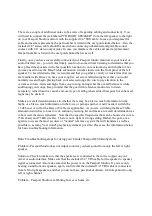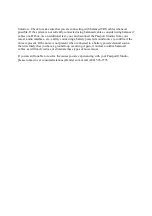
Usage and Troubleshooting for the Fender®
Passport® Studio Powered Monitor Speaker
System
The Passport® Studio reference monitor speakers are an excellent solution for high quality,
accurate and portable critical monitoring purposes. When using reference monitors, it is
important to keep some basic considerations in mind. First would be the environment that you
are using the monitors in. The Passport Studios have a very good "sweet spot". That is to say that
they offer an excellent representation of the frequency range available at a near listening distance
and are able to be used in a variety of different environments very effectively.
With this said, it is ideal to optimize your listening environment as much as possible. Some
simple things you can do include room selection (where possible). Select a room that is less
reverberant and one that has some soft surfaces such as carpeting and draperies, etc. to help
balance any hard/reflective surfaces. Also, as mentioned in the user guide (see Related
Downloads below), placement in the room and creating an equilateral triangle (equal distance
triangle) is very important to get the best results from your Passport Studio monitors. The main
idea here is to create an equal distance triangle that is also at an optimal height. Additionally, be
mindful not to place your Passport Studio monitors too close to walls or corners in the chosen
listening environment.
Some users may be interested in acoustic control products - even for a mobile environment. The
proper usage of these products can enhance the experience of "mobile engineering". There are a
number of different products available that are intended for mobile or portable use. An internet
search of the term "portable acoustic treatment products" will show a variety of options. This
being said, your Passport Studio monitors have been designed to optimize whatever listening
environment that you are in, so that you can achieve the accurate monitoring, even in less than
ideal locations.
Next, paying attention to the types of cables used to connect your Passport Studio monitors can
be very beneficial toward achieving a quiet and clean audio signal. As noted in the user guide,
the Passport Studio monitors include balanced 1/4 inch (TRS) jacks on the rear panel. These
input jacks are an ideal way to go whenever possible, as using balanced audio cables helps to
eliminate possible noise and ground loops, etc. Using balanced, shielded audio cables will
require that the signal you are outputting has balanced output jacks (TRS or XLR). If the output
source you are coming from does not have balanced output jacks, you can use an ungrounded
1/4" TS cables to connect to the rear left and right inputs as well.
If you encounter noise issues when connected to your Passport Studio monitors with unbalanced
cables, again, try balanced cables if possible. Optionally, if the output source is unbalanced, you
can use a direct input or "DI" box to "balance" the output from your source by connecting the
unbalanced line to the DI box, then connecting a balanced line from the DI box to the Passport
Studio monitor's rear panel input jacks. For more information and pricing on DI boxes, please
check in with your local music or pro audio retailer.



